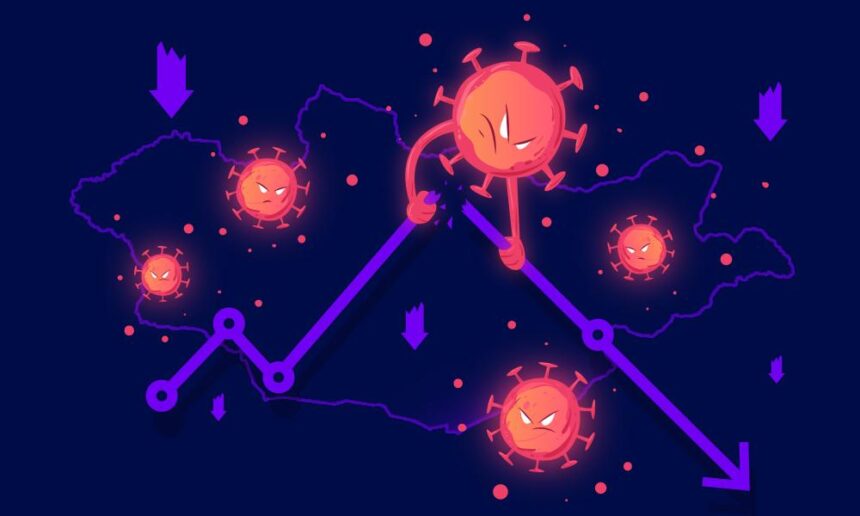The COVID-19 pandemic that shocked humanity in the beginning of 2020 has now infected 63.4 million people and killed 1.47 million. Two-thirds, 40.8 million people, have been cured, and 2.3 percent have perished.
In Mongolia, the pandemic has affected 819 people since March 10. 376 cases were locally transmitted since November 10. 365 people were cured, and no one died. In the last ten days, an average of 10,000 people has been tested every day, and 22 new cases have been recorded.
Mongolia first adopted the ” Law on Disaster Protection” in 2017 and amended it on May 14, 2020. Disasters are defined as “disasters and accidents that result in loss of life and health of many people, loss of livestock, property, historical and cultural artifacts, and damage to the environment beyond the domestic or local economic and social resources and capacities.” The law dictates that the three levels of disaster preparedness are: daily, increased, and national. Mongolia has been on an increased preparedness level since February 12, 2020, and on November 12, 2020, it has switched to the national level. The Ulaanbaatar, Selenge, and Arkhangai provinces will remain on the national preparedness level until the end of December 10, and the preparedness level elsewhere was reduced to an increased level.
Health of the economy
Mongolia’s economy exhibits economic backwardness and is completely dependent on mining and its two neighbors. Because there is no stable institution for the government to manage private and public enterprises equally. Therefore, no one thinks about the state budget, increasing the tax base, or creating free competition, which is the driving force of the market economy that further increases labor productivity. Instead, officials focus on tax collection and distribution.
The income is usually estimated on the condition of increasing coal and copper exports. For example, it was planned to export 42 million tons of coal a year for three years, but in 2019 it was 36 million tons, and this year it will be only 30 million tons. The 2021 budget will have a deficit of 2.1 trillion tugriks or 5.1 percent of GDP, of which 1.2 trillion will be borrowed in domestic bonds, and the rest will be borrowed from the IMF. The 2021 budget envisages depositing 1.1 trillion tugriks for the Future Heritage Fund and 156 billion tugriks for the Budget Stabilization Fund.
The government has been pursuing an expansionary fiscal policy. Over the past ten years, the economy has grown tenfold, budget expenditures increased 26.6 times, the money supply increased 80.4 times, and the tugrik depreciated 2.35 times.
The country’s foreign debt has risen sharply. As of the third quarter of 2020, the government’s external debt reached USD 8 billion, the Bank of Mongolia 2.1 billion, commercial banks and NBFIs 1.8 billion, other sectors 8 billion, and inter-company loans 11.2 billion, a total of USD 31.2 billion (according to Bank of Mongolia statistics). This is 42.2 trillion tugriks, which is 2.1 times more than the economy at the current exchange rate (2850 MNT = 1 USD) or 14.8 billion dollars.
Circulation of the economy
Money should keep circulating in the economy. Mongolia’s money circulation was slow even before the pandemic. Ten years ago, the velocity ratio (M2) was at 4.7, but now it has decreased by 2.7 times to 1.7. The rate at which commercial banks change their holdings is quite low or slow. It can be linked to the Bank of Mongolia drastically increasing the money supply, commercial banks issuing relatively long-term loans, and increased non-performing loans.
Money supply (M2) increased by 58.5 percent from 7.6 trillion tugriks in 2012 to 12 trillion tugriks in 2016. The Bank of Mongolia’s price stabilization sub-programs, as well as ASEM spending and the government’s increase in borrowing from banks were the main reasons for this. N. Zoljargal, who was appointed as the President of the Bank of Mongolia at the end of 2012, supplied 3 trillion tugriks into the market through the “Price Stabilization Sub-Program” and 4 trillion tugriks through soft mortgage loans. Housing prices have doubled since the program was announced.
Between 2012 and 2016, tugrik savings increased by 65.3 percent, foreign currency savings by 93.8 percent, and foreign currency checking accounts by 67.3 percent. As of October 2020, 70 percent of bank accounts and 40 percent of total savings are in dollars. This figure was 41 percent and 24 percent at the beginning of the year, indicating that the banking sector is dollarizing. This is because the interest rate on MNT and USD saving is almost 2.5 times different. To maintain the dollar exchange rate, the Bank of Mongolia has supplied an average of $200 million a month to the market through 2020.
To support issuing loans, the Bank of Mongolia lowered its policy rate to 6 percent. On social media, citizens continue to demand zero bank interest rates and zero deposit rates. It is doubtful whether banks will support the economy by issuing loans, even if the policy rate is lowered and the deposit rate is reduced to zero. As of October 2020 (Bank of Mongolia news), commercial banks have 15 trillion tugriks in cash, of which 5.4 trillion tugriks were in the form of central bank bills (CBBs), and 1.6 trillion tugriks were government receivables and bonds. The possession of the amount of money this large is linked to the fact that banks are doing risk-free business only by issuing low-risk, high-turnover mortgages, and selling them to the Bank of Mongolia or buying bonds the government issues to cover the budget deficit. Banks have almost ceased to act as financial intermediaries.
The notion that the economic crisis is overcome through bank loans is deeply ingrained in people’s minds. Balance sheets clearly indicate that the results of many programs, such as price stabilization and mortgage lending, are in favor of banks and their owners, and not in favor of the citizens or borrowing companies. Mongolian commercial banks now have more cash than the government and tens of times more assets than companies, with the primary source being taxpayers’ money.
International economists and scholars continue to warn about the economic consequences of Covid-19 which are damaging the vulnerable groups the most. It is improbable that they have bank accounts, let alone have access to bank loans. According to the World Bank, 29 percent of Mongolia’s population is impoverished, living on less than $1.9 or 5,500 tugriks per person a day. Another 14 percent of the population is close to slipping down into this category. Therefore, our economic policy to overcome Covid-19 should aim at keeping the poverty level in check while focusing on this target group. Reducing the price of improved fuels, for example, is the right policy for 1 million people in ger quarters. Furthermore, support is needed to maintain jobs in the service areas where low-income people work that are suffering the most rather than on a nation-wide scale.
2020.12.03
Trans. by Riya.T and Munkh-Erdene.D












